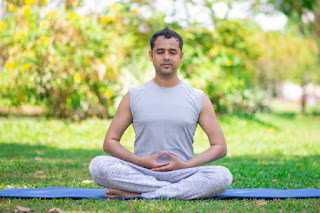Breath work for Sleep: Unlocking Calm with Pranayama
Breath work for Sleep: Unlocking Calm with Pranayama
Achieving restful sleep is a challenge for many, especially in times of stress or anxiety. Tossing and turning, racing thoughts, or waking up in the middle of the night can quickly turn bedtime into a source of frustration. While there are many approaches to improving sleep, breathwork—specifically the ancient yogic practice of Pranayama—is a powerful, natural method to calm the nervous system and ease you into a deep, restorative slumber.
Pranayama involves controlled breathing techniques that help manage the body’s stress response, allowing you to let go of tension, quiet the mind, and prepare the body for sleep. In this article, we’ll explore how pranayama addresses common sleep issues, provide detailed instructions on key techniques, and offer guidance on overcoming challenges that often arise in breathwork practices. Remember, the goal is progress, not perfection—small, consistent steps lead to lasting change.
How Pranayama Improves Sleep Quality
Breathing is an unconscious act that we do every day, yet it has a profound impact on our physical and mental well-being. When practiced with intention, breathwork can significantly influence how we feel, think, and even sleep.
Activates the Parasympathetic Nervous System:
Pranayama triggers the parasympathetic nervous system (often called the “rest and digest” system). This system works to counterbalance the stress response activated by the sympathetic nervous system, which keeps you in a heightened state of alertness. By focusing on slow, deep breathing, you can lower your heart rate, reduce blood pressure, and signal to your body that it’s time to relax and prepare for sleep.
Reduces Anxiety and Racing Thoughts:
Many people struggle with sleep because their minds are filled with racing thoughts or worries from the day. Breathwork techniques like Nadi Shodhana and 4-7-8 breathing help focus the mind on the present moment and create a calm mental state, reducing anxiety and allowing thoughts to slow down.
Balances Hormones and Lowers Cortisol:
Stress causes the body to release cortisol, a hormone that keeps you alert. Elevated cortisol levels, especially in the evening, can make it difficult to fall asleep. Pranayama helps lower cortisol levels, allowing your body to enter a more restful state.
Improves Oxygenation and Circulation:
Deep breathing increases oxygen flow to the brain and body, improving circulation and promoting a sense of relaxation. This increased oxygenation helps support better sleep by ensuring your body’s cells are properly nourished and rejuvenated.
Regulates Sleep Patterns:
Regular practice of pranayama can improve the overall quality of your sleep, helping you fall asleep faster and stay asleep longer. With consistent breathwork, your body becomes accustomed to this routine of relaxation, allowing for more stable sleep cycles.
Common Sleep Issues Pranayama Can Address
Whether you’re struggling to fall asleep, stay asleep, or wake up feeling unrested, pranayama offers solutions. Here’s how breathwork can help with specific sleep-related problems:
- Insomnia or Difficulty Falling Asleep: Stress and an overactive mind often prevent people from falling asleep quickly. Breathwork techniques calm the mind and activate the parasympathetic nervous system, making it easier to let go of the day’s worries.
- Waking in the Middle of the Night: If you frequently wake up during the night, pranayama can help you return to sleep faster. Techniques like 4-7-8 breathing encourage deep relaxation, helping your body re-enter a sleep state more easily.
- Restless Sleep: Pranayama improves overall sleep quality by promoting deeper, more restorative sleep. With regular practice, you may notice that you wake up feeling more refreshed and energized.
Techniques to Practice Before Bed
Nadi Shodhana (Alternate Nostril Breathing)
Overview: Nadi Shodhana is a balancing breath technique that alternates between the nostrils, helping to harmonize the brain and body. It’s especially effective at calming the mind and reducing anxiety, making it easier to unwind and prepare for sleep.
Step-by-Step Instructions:
- Sit comfortably with your spine tall and shoulders relaxed. Use your right thumb to gently close off your right nostril.
- Inhale deeply through your left nostril, feeling the breath fill your lungs.
- Close your left nostril with your ring finger and release your right nostril, exhaling fully through the right.
- Inhale through the right nostril, close it with your thumb, and release the left nostril to exhale through the left.
- Continue this pattern, alternating nostrils, for 5-10 minutes, focusing on even, controlled breathing.
Common Mistakes:
- Shallow Breathing: One of the most common mistakes is breathing too shallowly, which reduces the effectiveness of the technique. Focus on deep, diaphragmatic breaths, allowing your belly to expand on each inhale.
- Tension in the Face or Shoulders: It’s easy to hold tension in the shoulders or face during breathwork. Regularly check in with your body and consciously relax any areas of tension.
- Rushing the Breath: This technique works best when performed slowly. Take your time, especially with each exhale, which helps activate the parasympathetic nervous system.
Tips for Success: If you find it difficult to coordinate the breath with closing the nostrils, practice slow, even breathing through both nostrils before incorporating the alternating pattern. With practice, the coordination will become smoother.
4-7-8 Breathing
Overview: The 4-7-8 breathing technique is designed to promote relaxation by extending the exhalation. This triggers the body’s relaxation response, making it easier to fall asleep.
Step-by-Step Instructions:
- Sit or lie down in a comfortable position, placing your hands gently on your lap or at your sides.
- Close your eyes and inhale quietly through your nose for a count of four.
- Hold your breath for a count of seven, keeping your body relaxed.
- Exhale slowly through your mouth for a count of eight, making a soft “whooshing” sound.
- Repeat the cycle four to six times, focusing on the smoothness and length of your breath.
Common Mistakes:
- Holding the Breath with Tension: Many people hold their breath too tightly during the seven-count hold. Try to relax during this phase and avoid creating unnecessary tension.
- Exhaling Too Quickly: The exhale is the key part of this technique. If you find yourself rushing it, practice lengthening your exhalation by consciously slowing it down.
- Feeling Lightheaded: If you feel dizzy, reduce the number of cycles and shorten the breath holds until your body becomes accustomed to the rhythm.
Tips for Success: This technique is best practiced right before bed while lying down. It’s a gentle yet powerful way to ease your body into sleep mode.
Overcoming Common Challenges in Breathwork
Like any new practice, breathwork can present challenges, especially for those new to pranayama or experiencing high levels of stress. Here’s how to address some of the most common frustrations:
- Difficulty Staying Focused: It’s normal for the mind to wander during breathwork, especially when you’re trying to calm down for sleep. Instead of resisting distractions, gently bring your focus back to the breath. Consider using a mental cue, such as silently saying “inhale” and “exhale,” to anchor your attention.
- Impatience with Progress: Breathwork is not a quick fix, but rather a practice that builds over time. You may not notice immediate changes in your sleep after one session, but with consistency, you will see lasting benefits. Be patient and trust the process.
- Restlessness: If sitting still feels difficult, start with shorter breathwork sessions—two or three minutes—and gradually increase the duration. You can also combine breathwork with gentle yoga poses to release physical tension before focusing on the breath.
Alternative Approaches and Mental Frameworks
For those who find it challenging to practice traditional pranayama, here are some alternative approaches:
- Guided Breathwork Apps: Many apps, such as Calm or Insight Timer, offer guided breathwork sessions with soothing visual and audio cues. These can be a helpful way to stay focused if counting breaths feels overwhelming.
- Visualization with Breath: Pairing breathwork with visualization can deepen the practice. As you inhale, imagine drawing in peaceful energy, and as you exhale, visualize releasing tension from your body. This mental imagery can make it easier to stay engaged in the practice.
- Movement with Breath: Some people find it easier to synchronize their breath with movement. A slow walking meditation or gentle yoga sequence before bed can help you connect more deeply with your breath while preparing the body for sleep.
Additional Resources for Further Reading
For more insights into relaxation techniques, stress relief, and balancing your life through yoga and meditation, you may find these articles helpful:
- “Unlocking Serenity: 10 Proven Yoga and Meditation Techniques for Stress Relief”
- “From Chaos to Calm: A Guide to Using Meditation and Yoga for Balance”
These resources offer further guidance on how to integrate yoga and meditation into your daily life for better mental and physical health.
Conclusion
Breathwork, specifically pranayama, is a powerful tool to help you achieve better sleep. By incorporating techniques like Nadi Shodhana and 4-7-8 breathing into your nightly routine, you can calm your nervous system, reduce anxiety, and prepare your body for rest. Remember, consistency is key, and over time, these small efforts will add up to significant improvements in your sleep quality.
Take your time, be patient with yourself, and allow breathwork to become a natural part of your bedtime routine. The journey to better sleep is one breath at a time.










